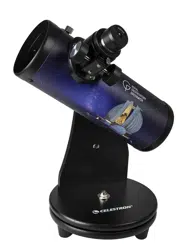Loading ...
Loading ...
Loading ...

ENGLISH | 9
There are five planets that are visible to the naked eye - Mercury, Venus, Mars, Jupiter and Saturn. To the unaided eye,
these planets will look similar to stars. Uranus and Neptune are too faint to see with the unaided eye, but in a telescope
they will appears as slightly bloated stars. Planets change positions against the background stars on a daily basis. Don’t
fear, though. With a little preparation and some knowledge of what to expect, you will be able to pick them out of the sky
and find them in your telescope quite easily.
First, go online and use your favorite search engine to look for “visible planets.” You will find a large number of web sites
that offer printable planet finder charts that are good for the current month. These charts will usually specify a time and
date to use them. For example, the map may show the sky at 11:00 PM for the beginning of the month, but may also be
used at 10:00 for mid-month dates and 9:00PM at the end of the month. Hold the chart over your head and rotate the
chart so that the north part of the map is facing north. Match up the brighter stars and constellations shown on the chart
with the stars you can actually see and then look for the planets pointed out on the chart.
Other web sites may have more accurate interactive star charts. To use these, you need to enter the date, time, and your
location and the site will generate a map of the stars with plotted positions of the planets. You can print the charts and
take them outside with you when you observe. As with the charts described above, you would need to hold them over your
head with north on the map pointing north to use them correctly.
Even though planets move against the stars from day to day, they stay in a very limited strip of sky, called the ecliptic.
Planets are usually the brightest objects along the ecliptic.
Observing Mercury and Venus
Because Mercury and Venus orbit so close to the Sun, they never appear to stray too far from it in
the sky. As a result, these planets are usually seen in the early dawn before sunrise or twilight after
sunset. You only have a short time to view these planets before they set below the horizon or the
glare from the rising sun swallows them up. Mercury is always so low to the horizon that magnified
images will rarely offer more detail than a small ruddy disk. Venus will rise higher and is, at times,
brighter than anything in the sky other than the Sun and Moon. It is so bright that many people
mistake it for an airplane. Due to the high amount of cloud cover on Venus, you will never see any
surface detail, but you can see the planet go through phases like the Moon, from a small crescent
to a large gibbous as it circles the Sun. If you view these planets, it is best to do this when the Sun
is fully below the horizon to avoid accidentally viewing the Sun through your telescope, which can
cause irreversible damage to your eye.
Observing Mars
Mars orbits farther from the Sun than Earth does. During opposition, when the Earth and the planet
are closest to each other, the planet will rise at sunset and be visible in the sky all night. Due to the
relative speeds of Earth and Mars, Mars only comes into opposition once every two years. Around
the time of Mars’ opposition, the planet is at its largest and can start to show some subtle detail
such as a polar cap and some shading of surface features. At opposition, it is possible to see one
of the polar caps with a small telescope.
Observing Uranus and Neptune
Uranus and Neptune are too far away to show any detail. Even under high power, they appear
slightly larger than a star, but what is really noticeable about these planets in an eyepiece is their
stunning greenish-blue color.
PRACTICE WHAT YOU HAVE LEARNED: OBSERVING THE PLANETS
Loading ...
Loading ...
Loading ...
